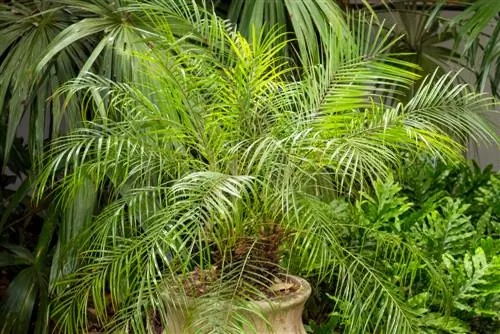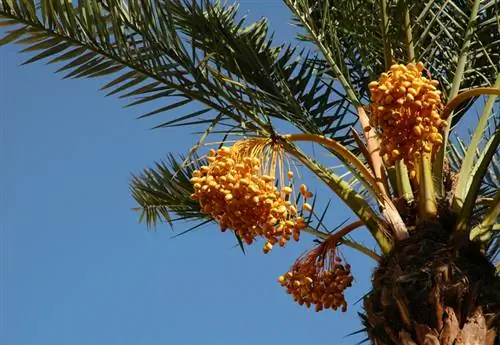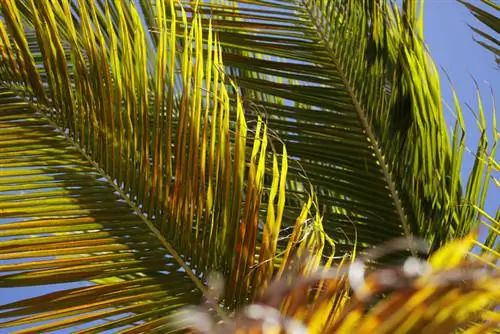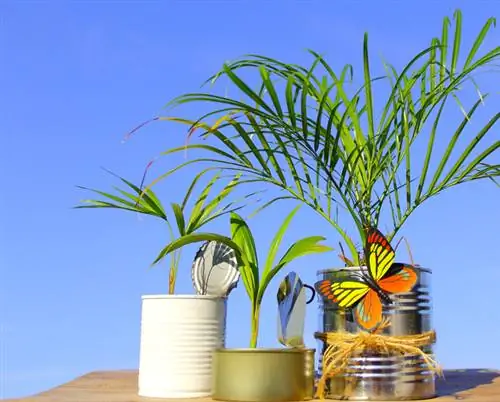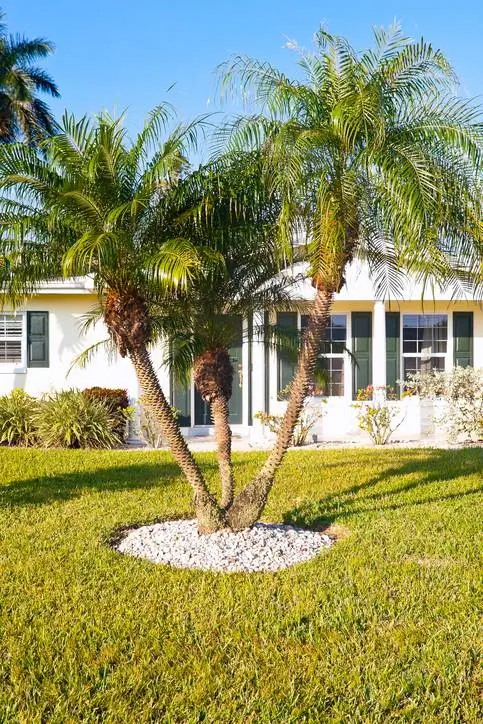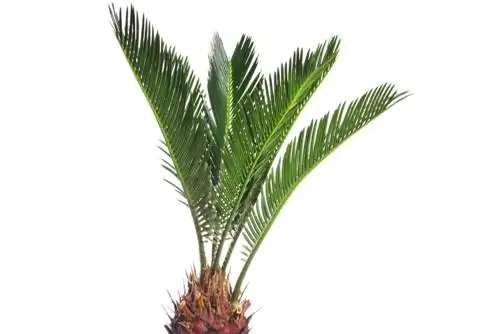- Author admin [email protected].
- Public 2023-12-16 16:46.
- Last modified 2025-06-01 06:02.
Read a commented dwarf date palm profile here with information about growth, leaves, flowers and winter hardiness. Many tips and tricks explain how to properly plant and care for Phoenix roebelenii.
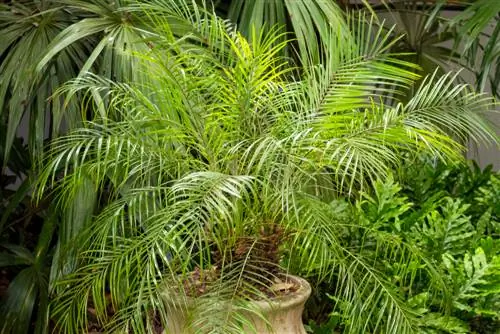
How do you properly care for a dwarf date palm?
The dwarf date palm (Phoenix roebelenii) is an evergreen, frost-sensitive palm from Southeast Asia. It prefers partially shaded to shady locations with high humidity and temperatures of at least 16°C. Care tips include regular watering with low-lime water, fertilizing every two weeks during the growing season and overwintering at room temperature.
Profile
- Scientific name: Phoenix roebelenii
- Family: Palm family (Arecaceae)
- Origin: Southeast Asia
- Growth type: palm tree
- Growth habit: multi-stemmed, spreading
- Growth height: 100 cm to 300 cm
- Leaf: pinnate
- Flower: panicle
- Fruit: Berry
- Roots: taproot
- Winter hardiness: not hardy
- Use: potted plant
Growth
The dwarf date palm is a species of palm tree of the genus date palm (Phoenix) found in Southeast Asia. In this country, Phoenix roebelenii is highly valued as a pot plant due to its picturesque, compact growth with these characteristics:
- Growth habit: single- or multi-stemmed palm with dense leaves made of magnificent feathery fronds.
- Growth height as a pot plant: average up to 100 cm, rarely 200 cm to 300 cm.
- Stem: fibrous, upright or twisted, slender, diameter without leaf bases up to 10 cm.
- Stem peculiarity: less fibrous to smooth with age and covered with diamond-shaped bases of cut leaves.
- Roots: Taproot with a dense network of fine roots.
- Ghorticulturally interesting features: sprawling, easy to care for, sensitive to frost, non-toxic, likes to form shoots for propagation, ideal type of palm for beginners.
Video: Dwarf date palm - a houseplant worth seeing
Leaf
On the slender palm trunk of a dwarf date palm sits a lush, sprawling crown of leaves with these features:
- Leaf shape: arching, overhanging, long-stemmed, pinnate fronds with fibrous, reddish-brown leaf sheath.
- Leaf size: 100 cm to 150 cm long, rarely up to 200 cm.
- pinnate leaves: opposite, linear, up to 40 cm long and 1.5 cm wide.
- Leaf color: evergreen, dark green.
- Special feature: up to 8 cm long, orange-green thorns on the leaf stem.
Bloom
The dwarf date palm is a dioecious, separate-sex palm species. Male and female flowers unfold on separate palms. You can find out the flower characteristics of a Phoenix roebelenii worth knowing in this overview:
- Inflorescence: long-stemmed panicle with numerous individual flowers.
- Single flower: three-lobed, cup-shaped, inconspicuous.
- Flower color: yellow white or light green.
- Flowering time: April/May to June/July.
Male and female dwarf date palms can be distinguished by the position and color of their inflorescences. Male flower spikes are pendulous with yellowish-white individual flowers. Female flower spikes are upright with light green individual flowers.
Winter hardiness
A dwarf date palm is extremely sensitive to frost with a minimum temperature of 16° Celsius. In this respect, the small-growing palm species differs from popular counterparts such as the Canary Island date palm (Phoenix canariensis) or the real date palm (Phoenix dactylifera). These are conditionally hardy and can survive short-term frost down to -5° Celsius.
Planting dwarf date palm
You can buy ready-to-plant Phoenix roebelenii in garden centers and online shops for prices starting at 45 euros for an 80 centimeter tall specimen. Planting is easier after propagation through cuttings, which like-minded hobby gardeners sell inexpensively. Don't miss these planting tips:
Propagation
As a container plant, the dwarf date palm rarely or never produces fruits with seeds that could produce offspring. The palm makes a virtue of this necessity and produces lateral offshoots at the base of the trunk. The Kindel are the perfect starting material for promising propagation. This is how it works:
- Cut offshoots with their own roots and leaves from the mother plant.
- Fill deep cultivation pot with equal parts of peat-free palm soil and coconut soil.
- Moisten the substrate with soft water.
- Plant Kindel as deep as before next to its mother plant.
- Water and spray regularly in a bright, warm window seat.
In contrast, sowing is a gardening challenge that requires an epic amount of patience. The dark-germinating seeds of a Phoenix roebelenii are placed 2 cm deep in seed soil. Under the influence of a constantly high humidity of 80 percent at 27° to 30° Celsius, germination takes around 16 weeks. It takes another 2 to 3 years for the undivided cotyledon to be followed by a first leaflet.
Planting
You can plant a dwarf date palm from your own propagation in a decorative pot as soon as the cultivation pot is completely rooted. All the important key data for the correct planting can be read:
- Bucket: deep container with space for the taproot, bottom opening as a water drain, two finger widths larger in diameter than the root ball.
- Substrate: Special palm soil or a mix of peat-free potting soil, coconut soil, quartz sand and lava granules.
- Preparation: Place roots in lime-free water until no more air bubbles rise.
- Planting technology: Fill in the substrate over expanded clay drainage, plant a potted dwarf date palm, leave the watering edge free, press down the soil and water thoroughly.
Location
At this location the dwarf date palm shows its most beautiful side:
- Indoors and outdoors in all partially shaded to shady, warm locations with the highest possible humidity.
- From May to August/September, preferably on the balcony or terrace in a place protected from the wind in partial shade.
- Year-round minimum temperature: 16° Celsius.
Excursus
Increase humidity - tips & tricks
High humidity is a key issue in perfect Phoenix roebelenii care. It's so easy to boost the humidity in living rooms to subtropical levels: fill pot saucers with expanded clay and water. Set up a humidifier (available on Amazon from 35 euros). Hang the ceramic water evaporator on the radiator. Place an indoor fountain next to the dwarf date palm (available on Ebay from 25 euros). The ultimate solution is an aquarium where a dwarf date palm will never complain about brown leaves.
Care for dwarf date palm
In a partially shaded, warm location, the dwarf date palm proves to be very easy to care for. The uncomplicated water and nutrient supply depends on the season. No pruning care is required. Compared to other date palms, overwintering is easy. Problems in cultivation are usually due to care errors and are rarely due to disease or pest infestation. These care tips are good to know for hobby gardeners:
Pouring
The dwarf date palm wants an alternately moist substrate. With this casting technique you can meet your care needs:
- Dwarf date palms should be watered thoroughly in summer if the substrate surface is noticeably dry (thumb test).
- In winter, watering is more economical without causing waterlogging or dryness of the bales (insert the watering indicator into the substrate).
- Use low-lime water as irrigation water, preferably collected, filtered rainwater or decalcified tap water.
- Spray palm fronds regularly with decalcified water as long as no rays of sunlight are falling on the leaves.
Fertilize
From April to September, fertilize the dwarf date palm every two weeks with a liquid palm fertilizer. Special palm fertilizers are precisely tailored to the s alt sensitivity of a date palm. In winter, a Phoenix roebelenii is fertilized every six to eight weeks.
Cutting
Pruning is not necessary for the dwarf date palm. Occasionally a feather frond dries up. Cut off the fully retracted palm leaf. A short piece of the leaf base remains for an evenly beautiful trunk appearance, which is characteristic of palm trees.
Wintering
Phoenix roebelenii is a warm house palm species. This has the advantage that no separate winter quarters need to be reserved. This is how you properly overwinter a dwarf date palm:
- Preparation: water more sparingly from the end of August/beginning of September, extend fertilization intervals to six weeks.
- Putting away: from nighttime temperatures of 16° Celsius (hang up a minimum-maximum thermometer).
- Winter location: normal room temperatures, bright at 3000 lux daily (compensate for lack of light with plant lamps).
Repotting
The slow-growing dwarf date palm is repotted every three to four years. You should devote yourself to this care measure at the latest when the first roots appear on the surface of the substrate or peek out of the bottom opening of the pot. The new palm pot is no more than two to three finger widths larger in diameter than the root ball. How to properly repot a date palm:
- The best time is in spring.
- Unpot the dwarf date palm (loose the stuck substrate from the pot with a long kitchen knife).
- Shake off used substrate or rinse vigorously.
- Clean drainage material for reuse and place in the new palm pot.
- Mix fresh palm soil with expanded clay and fill in.
- Form a depression in the substrate to insert the root ball into.
- Press down the soil and water thoroughly.
It is important to note that you do not plant the dwarf date palm deeper than before. Otherwise, you could be depriving yourself of potential shoots at the base of the trunk, which are ideal for propagation at zero cost.
Diseases, pests, care errors
The following table provides a compact overview of typical damage patterns on a dwarf date palm with information on common causes and non-toxic countermeasures:
| malicious image | Cause | Countermeasure |
|---|---|---|
| Webs between the fronds | Spider mites | Shower the leaves vigorously and spray regularly |
| Black leaf nodules | Callus disease (Graphiola phoenicis) | Cut off infected leaves, improve conditions |
| Many brown leaves | Waterlogging | repotting, watering more sparingly |
| Single brown leaves | natural process | cut off dead leaf |
| Brown leaf tips | dry air | spray, set up humidifier |
| Yellow leaves | hard watering water | repotting, watering with rainwater |
| Brown or woolly leaf bumps | Scale insects, mealybugs | wipe, spray soap-spirit solution |
Popular varieties
There are no varieties of the dwarf date palm to buy.
FAQ
My dwarf date palm has brown leaves. Why is that?
A dwarf date palm responds to various care problems with brown leaves. The most common cause is waterlogging in winter because the water supply is not tailored to the greatly reduced need for watering. In this case, the plant should be repotted promptly. Brown leaves in summer are a typical symptom of drought stress. A dip in soft water solves the problem. However, individual brown leaves are not a cause for concern because the date palm occasionally pulls in old fronds on the lower leaf crest in exchange for new leaves in the middle of the tuft.
Which plant lamps are suitable for overwintering a dwarf date palm?
Grown lamps for overwintering a dwarf date palm should be very similar to sunlight. For this reason, special LED plant lamps with daylight white light color are recommended. LED bulbs use up to 90 percent less energy than classic light bulbs. With this in mind, you can safely light your Phoenix palm for 8 to 12 hours a day in winter without noticeably increasing energy consumption on your electricity bill.
Brown leaf tips spoil my dwarf date palm. What to do?
Ball dryness or too low humidity are the most common causes of brown leaf tips on a dwarf date palm. The Phoenix roebelenii cannot regenerate from this damage. However, you can repair the damage. Cut each brown leaf tip back to within 1mm of the green tissue. Nail scissors are well suited for precise cutting. As a preventive measure, you should regularly spray your date palm with low-lime water.

